Application of a Novel Nd:YAG/PPMgLN Laser Module Speckle-Suppressed by Multi-Mode Fibers in an Exhibition Environment
Abstract
:1. Introduction
2. Nd:YAG/PPMgLN Module at 561.5 nm
2.1. Properties of the Nd:YAG/PPMgLN Module
2.2. Spectral Characteristic of the Nd:YAG/PPMgLN Laser
3. Laser Speckle
4. Speckle-Suppressed Technology Based on Multi-Mode Fibers
4.1. Experimental Setup of Speckle-Suppressed Technology Based on Multi-Mode Fibers
4.2. The Dispersion Characteristics of the Multi-Mode Fibers
5. Results and Discussion
5.1. Multi-Mode Quartz Fibers
5.2. Multi-Mode Plastic Fiber
6. Conclusions
Author Contributions
Funding
Institutional Review Board Statement
Informed Consent Statement
Data Availability Statement
Acknowledgments
Conflicts of Interest
References
- Liu, X.; Seevers, R.; Gu, Z.; Yang, X. Smart MICE: Definitions, foundations and development. Proceedings of 7th International Conference on Information Science and Control Engineering (ICISCE), Changsha, China, 18–20 December 2020; pp. 1307–1311. [Google Scholar]
- Xiao, L. A conceptual framework for smart MICE ecosystem in China. In Proceedings of the 2017 Euro-Asia Conference on Environment and CSR: Tourism, Society and Education Session (Part I), Hamburg, Germany, 26–27 August 2017; Zhang, Y., Ed.; Wissenschaftlicher Verlag: Berlin, Germany, 2017; pp. 1–10. [Google Scholar]
- Bruno, F.; Bruno, S.; Sensi, G.D.; Luchi, M.-L.; Mancuso, S.; Muzzupappa, M. From 3D reconstruction to virtual reality: A complete methodology for digital archaeological exhibit. J. Cult. Herit. 2010, 11, 42–49. [Google Scholar] [CrossRef]
- Houston, J.; Beck, W. Design considerations for cinema exhibition using rgb laser illumination. SMPTE. Mot. Imaging J. 2015, 124, 26–41. [Google Scholar] [CrossRef]
- Liang, N. The application of the holographic laser projection in the entertaining performance. In Proceedings of the International Conference on Advanced Materials for Science and Engineering (ICAMSE), Tainan, Taiwan, 12–13 November 2016; pp. 629–631. [Google Scholar]
- Blanche, P.-A.; Bablumian, A.; Voorakaranam, R.; Christenson, C.; Lin, W.; Gu, T.; Flores, D.; Wang, P.; Hsieh, W.-Y.; Kathaperumal, M.; et al. Holographic three-dimensional telepresence using large-area photorefractive polymer. Nature 2010, 468, 80–83. [Google Scholar] [CrossRef] [PubMed]
- Caggianese, G.; Gallo, L.; Neroni, P. Evaluation of spatial interaction techniques for virtual heritage applications: A case study of an interactive holographic projection. Future Gener. Comp. Syst. 2018, 81, 516–527. [Google Scholar] [CrossRef]
- Li, D.; Kelly, D.P.; Sheridan, J.T. Speckle suppression by doubly scattering systems. Appl. Opt. 2013, 52, 8617–8626. [Google Scholar] [CrossRef]
- Hepburn, M.S.; Foo, K.Y.; Wijesinghe, P.; Munro, P.R.T.; Chin, L.; Kennedy, B.F. Speckle-dependent accuracy in phase-sensitive optical coherence tomography. Opt. Express 2021, 29, 16950–16968. [Google Scholar] [CrossRef]
- Song, Q.; Wang, G.; Zhang, B.; Wang, W.; Wang, M.; Zhang, Q.; Sun, G.; Bo, Y.; Peng, Q. Diode-pumped passively dual-wavelength Q-switched Nd:GYSGG laser using graphene oxide as the saturable absorber. Appl. Opt. 2015, 54, 2688–2692. [Google Scholar] [CrossRef] [PubMed]
- Liu, X.; Wen, Z.-W.; Song, S.; Song, L.-M.; Lin, H.-Y. Speckle-reduced green and yellow-green Nd:YVO4(YAG)/PPMgLN lasers for cinema exhibition industry. Optik 2021, 243, 167427. [Google Scholar] [CrossRef]
- Hansen, A.K.; Christensen, M.; Noordegraaf, D.; Heist, P.; Papastathopoulos, E.; Loyo-Maldonado, V.; Jensen, O.B.; Skovgaard, P.M.W. Efficient generation of 1.9 W yellow light by cascaded frequency doubling of a distributed Bragg reflector tapered diode. Appl. Opt. 2016, 55, 9270–9274. [Google Scholar] [CrossRef] [Green Version]
- Hofmann, J.; Blume, G.; Jedrzejczyk, D.; Eppich, B.; Feise, D.; Kreutzmann, S.; Sahm, A.; Paschke, K. Miniaturized diode laser module emitting green light at 532 nm with a power of more than 900 mW for next-generation holographic displays. Opt. Rev. 2016, 23, 141–145. [Google Scholar] [CrossRef]
- Song, S.; Lin, H.-Y.; Shi, W.-J.; Wen, Z.-W.; Ruan, J.-J.; Liu, H.; Sun, D. Small yellow-green Nd:YAG/PPMgLN laser module at 561.3 nm. Optik 2021, 232, 166557. [Google Scholar] [CrossRef]
- Lin, H.; Tan, H.; Miao, J.; Cui, T.; Su, S.; Guo, J. Extra-cavity, widely tunable, continuous wave MgO-doped PPLN optical parametric oscillator pumped with a Nd:YVO4 laser. Opt. Mater. 2009, 32, 257–260. [Google Scholar] [CrossRef]
- Xin, Z.; Hengli, Z.; Yefei, M.; Sihan, S. Efficient methods of green output by second harmonic generation with short pulse broad-band laser. Chin. J. Lasers 2016, 43, 0202003. [Google Scholar]
- Zaletelj, K.; Agrež, V.; Slavič, J.; Petkovšek, R.; Boltežar, M. Laser-light speckle formation for deflection-shape identification using digital image correlation. Mech. Syst. Signal Pr. 2021, 161, 107899. [Google Scholar] [CrossRef]
- Redding, B.; Choma, M.A.; Cao, H. Speckle-free laser imaging using random laser illumination. Nat. Photonics 2012, 6, 355–359. [Google Scholar] [CrossRef] [PubMed] [Green Version]
- Ma, Q.; Xu, C.-Q. Wavelength blending with reduced speckle and improved color for laser projection. Opt. Laser. Eng. 2017, 97, 27–33. [Google Scholar] [CrossRef]
- Trisnadi, J.I. Hadamard speckle contrast reduction. Opt. Lett. 2004, 29, 11–13. [Google Scholar] [CrossRef]
- Dadabayev, R.; Shabairou, N.; Zalevsky, Z.; Malka, D. A visible light RGB wavelength demultiplexer based on silicon-nitride multicore PCF. Opt. Laser Technol. 2019, 111, 411–416. [Google Scholar] [CrossRef]
- Shabairou, N.; Cohen, E.; Wagner, O.; Malka, D.; Zalevsky, Z. Color image identification and reconstruction using artificial neural networks on multimode fiber images: Towards an all-optical design. Opt. Lett. 2018, 43, 5603–5606. [Google Scholar] [CrossRef]
- Senarathna, J.; Rege, A.; Li, N.; Thakor, N.V. Laser speckle contrast imaging: Theory, instrumentation and applications. IEEE Rev. Biomed. Eng. 2013, 6, 99–110. [Google Scholar] [CrossRef]
- Yoon, Y.; Breshike, C.J.; Kendziora, C.A.; Furstenberg, R.; McGill, R.A. Reduction of speckle noise and mitigation of beam wander in tunable external cavity quantum cascade lasers using rotating diamond/KBr pellet coupled with multimode fiber. Opt. Express 2019, 27, 8011–8020. [Google Scholar] [CrossRef] [PubMed]
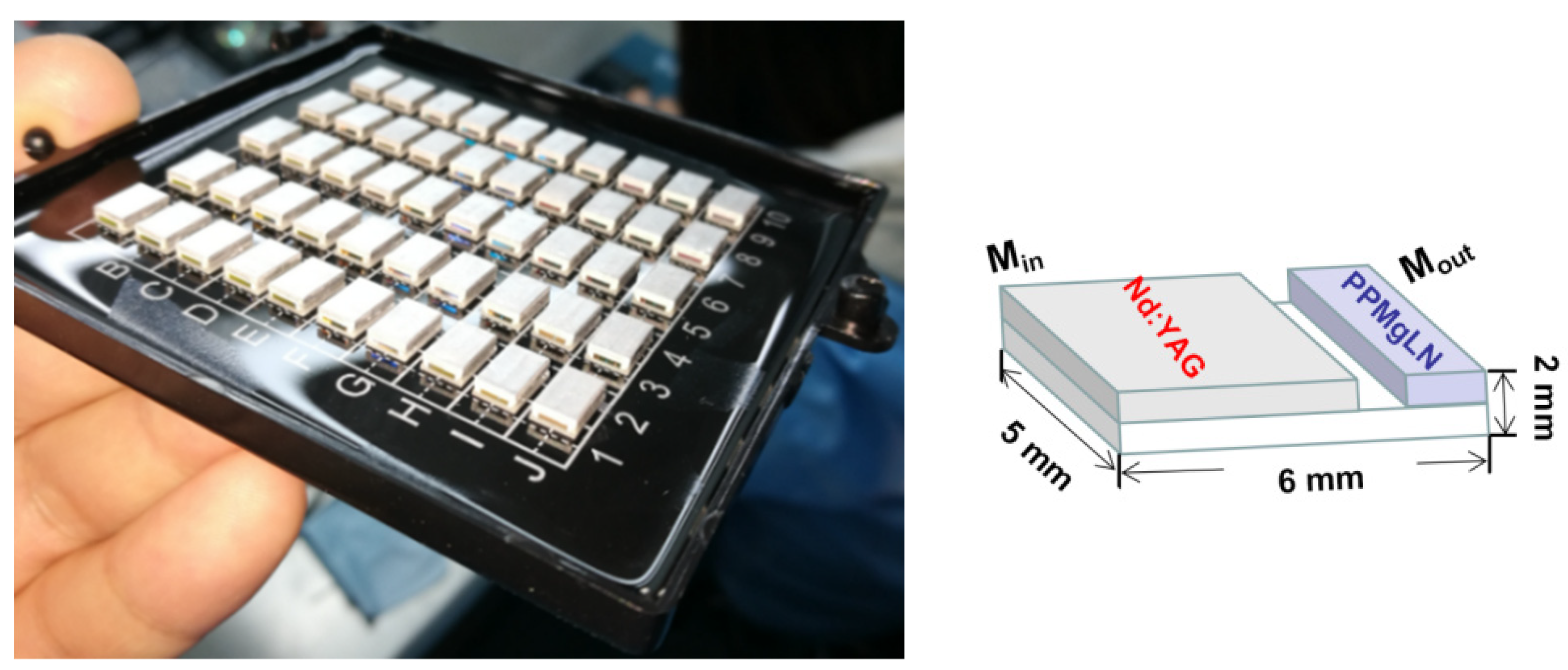
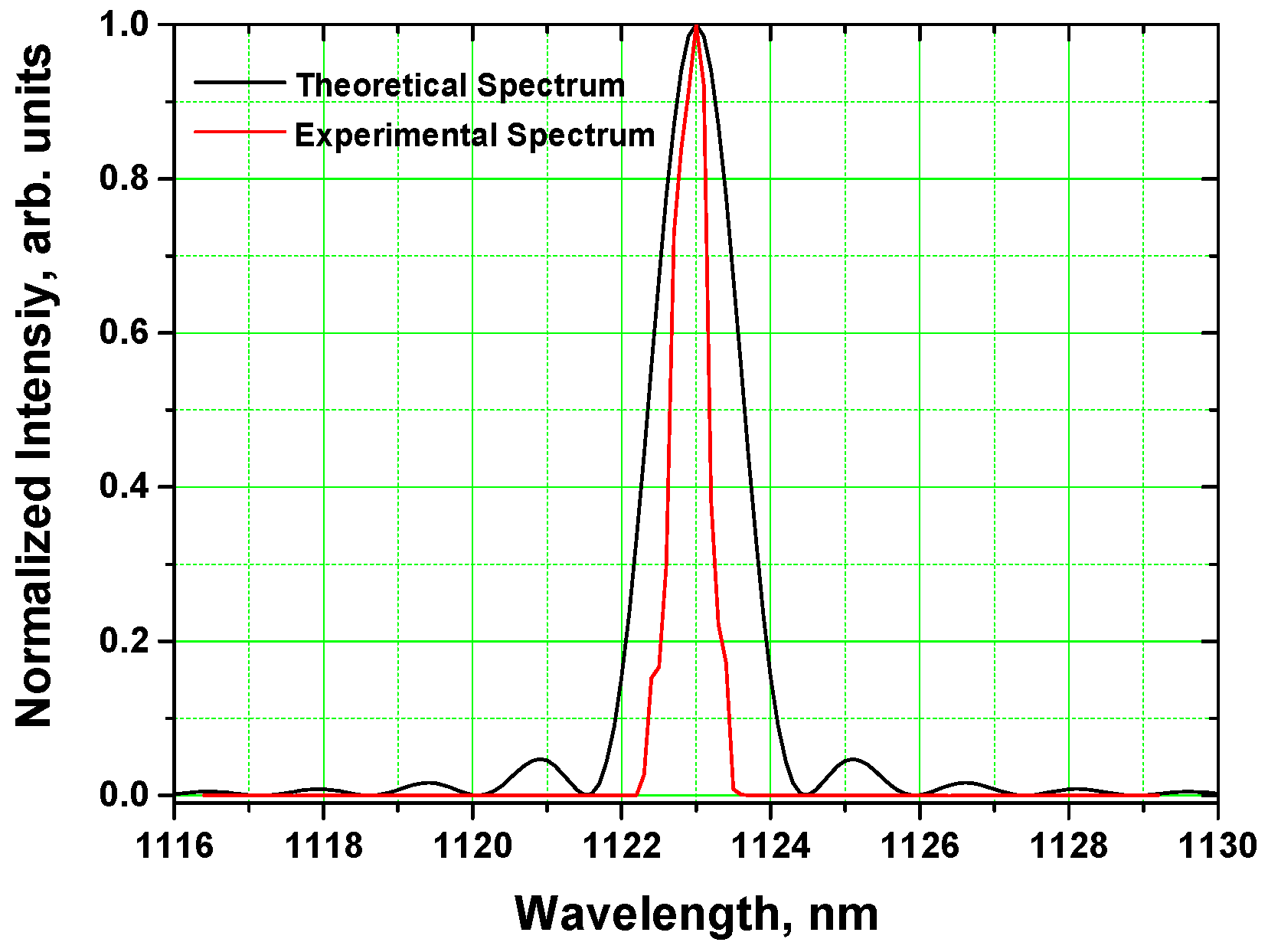

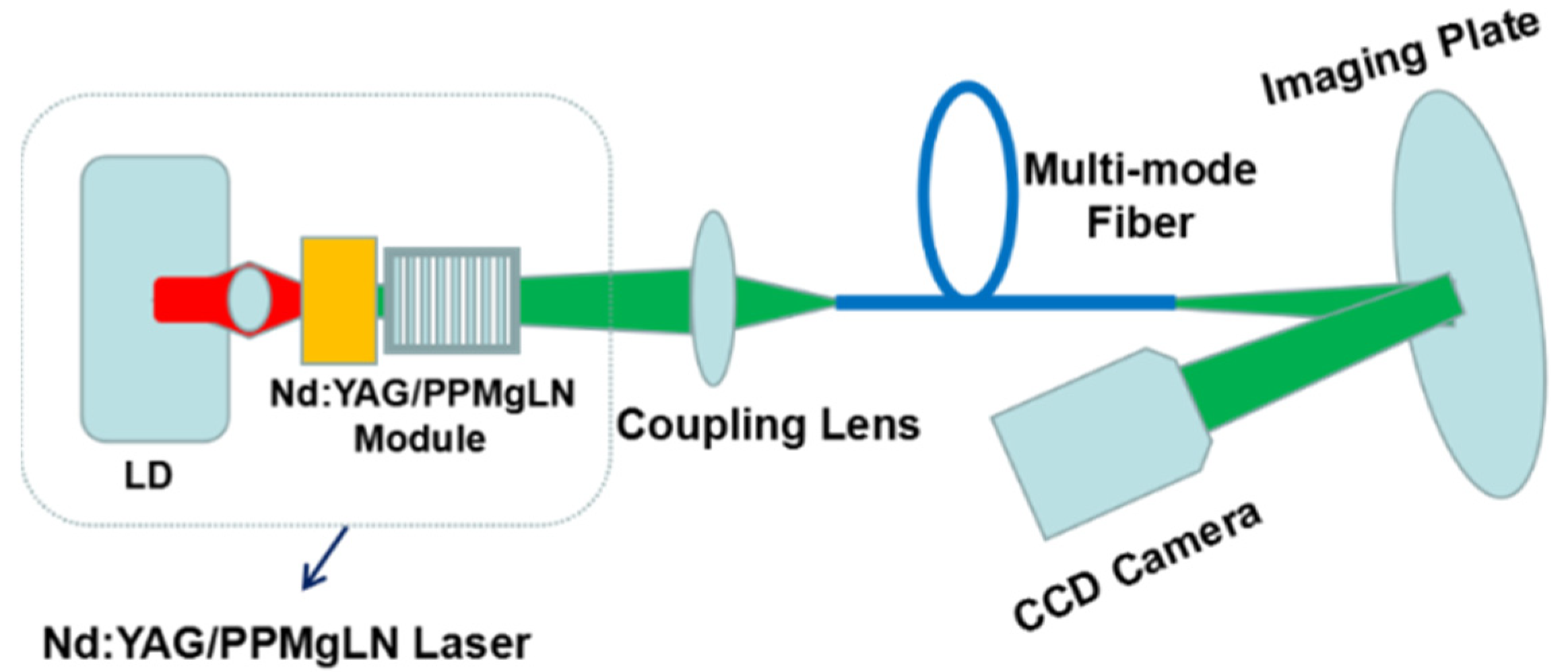
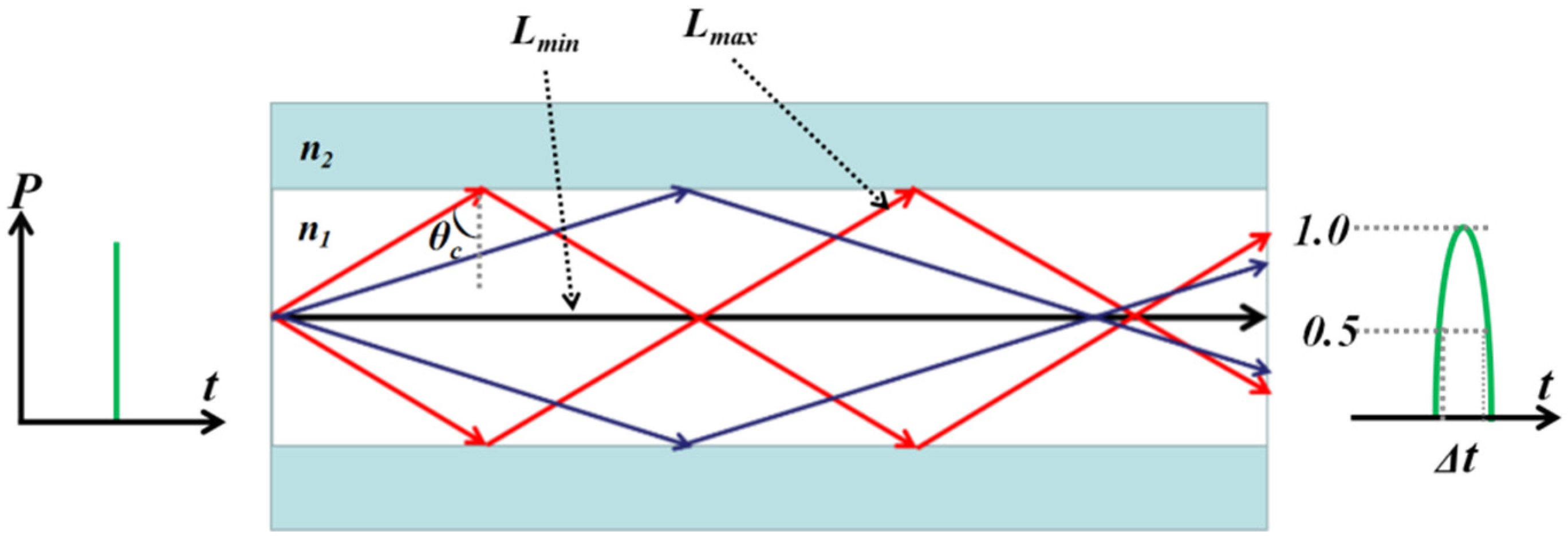
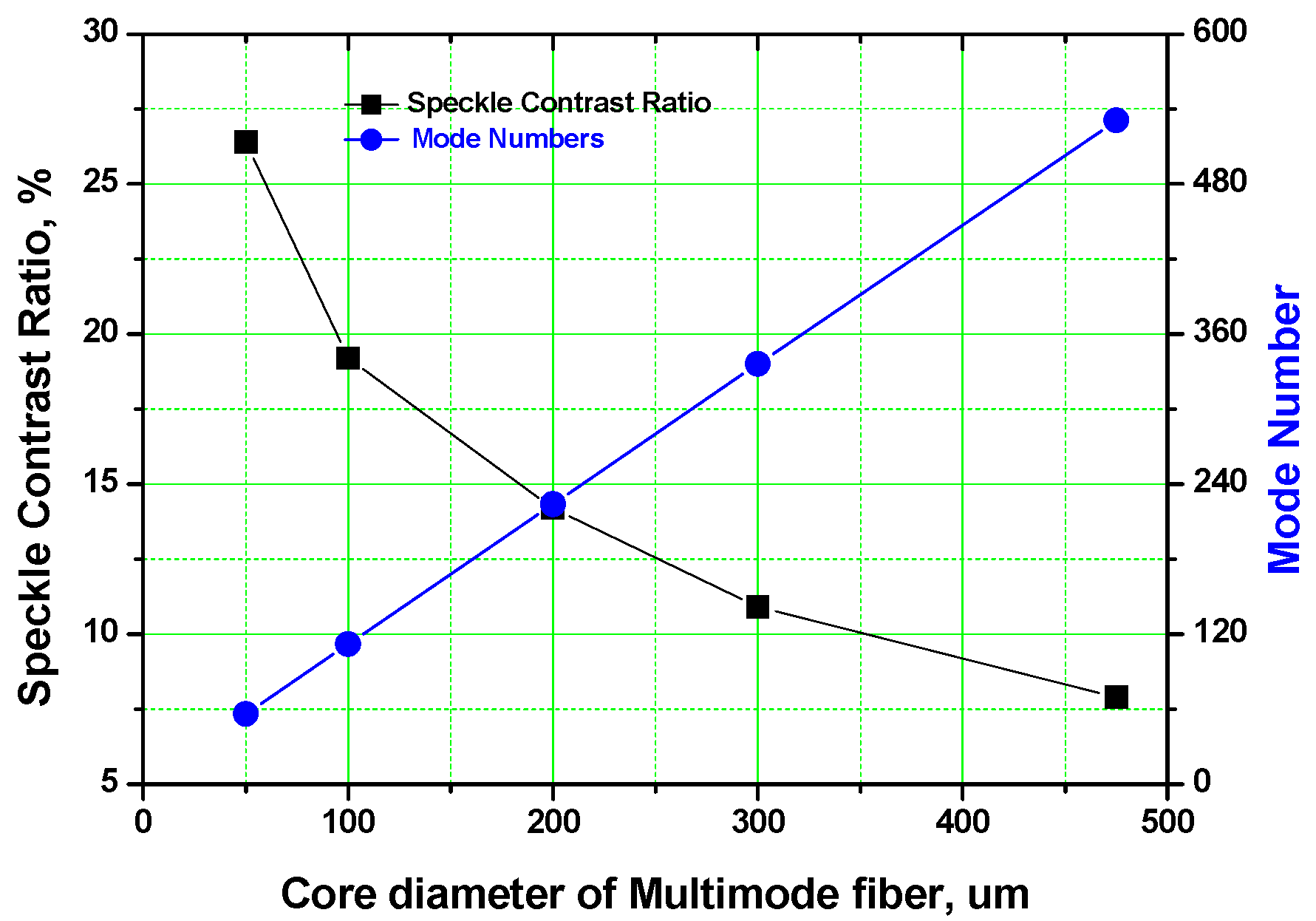



Publisher’s Note: MDPI stays neutral with regard to jurisdictional claims in published maps and institutional affiliations. |
© 2022 by the authors. Licensee MDPI, Basel, Switzerland. This article is an open access article distributed under the terms and conditions of the Creative Commons Attribution (CC BY) license (https://creativecommons.org/licenses/by/4.0/).
Share and Cite
Liu, X.; Zeng, X.-T.; Shi, W.-J.; Bao, S.-F.; Yu, T.; Lin, H.-Y. Application of a Novel Nd:YAG/PPMgLN Laser Module Speckle-Suppressed by Multi-Mode Fibers in an Exhibition Environment. Photonics 2022, 9, 46. https://doi.org/10.3390/photonics9010046
Liu X, Zeng X-T, Shi W-J, Bao S-F, Yu T, Lin H-Y. Application of a Novel Nd:YAG/PPMgLN Laser Module Speckle-Suppressed by Multi-Mode Fibers in an Exhibition Environment. Photonics. 2022; 9(1):46. https://doi.org/10.3390/photonics9010046
Chicago/Turabian StyleLiu, Xiao, Xin-Ting Zeng, Wen-Jian Shi, Shang-Feng Bao, Tao Yu, and Hong-Yi Lin. 2022. "Application of a Novel Nd:YAG/PPMgLN Laser Module Speckle-Suppressed by Multi-Mode Fibers in an Exhibition Environment" Photonics 9, no. 1: 46. https://doi.org/10.3390/photonics9010046
APA StyleLiu, X., Zeng, X.-T., Shi, W.-J., Bao, S.-F., Yu, T., & Lin, H.-Y. (2022). Application of a Novel Nd:YAG/PPMgLN Laser Module Speckle-Suppressed by Multi-Mode Fibers in an Exhibition Environment. Photonics, 9(1), 46. https://doi.org/10.3390/photonics9010046




